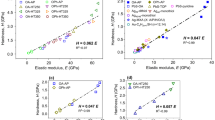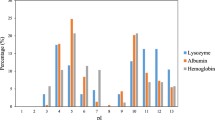Abstract
In the present research, hierarchical structure observation and mechanical property characterization for a type of biomaterial are carried out. The investigated biomaterial is Hyriopsis cumingii, a typical limnetic shell, which consists of two different structural layers, a prismatic “pillar” structure and a nacreous “brick and mortar” structure. The prismatic layer looks like a “pillar forest” with variation-section pillars sized on the order of several tens of microns. The nacreous material looks like a “brick wall” with bricks sized on the order of several microns. Both pillars and bricks are composed of nanoparticles. The mechanical properties of the hierarchical biomaterial are measured by using the nanoindentation test. Hardness and modulus are measured for both the nacre layer and the prismatic layer, respectively. The nanoindentation size effects for the hierarchical structural materials are investigated experimentally. The results show that the prismatic nanostructured material has a higher stiffness and hardness than the nacre nanostructured material. In addition, the nanoindentation size effects for the hierarchical structural materials are described theoretically, by using the trans-scale mechanics theory considering both strain gradient effect and the surface/interface effect. The modeling results are consistent with experimental ones.









Similar content being viewed by others
References
Xie, Z.Q., Yao, H.M.: Crack deflection and flaw tolerance in “brick-and-mortar” structured composites. Int. J. Appl. Mech. 6, 1450017 (2014)
Shao, Y., Zhao, H.P., Feng, X.Q.: On flaw tolerance of nacre: a theoretical study. J. R. Soc. Interface 11, 20131016 (2014)
Xu, J., Zhao, X.L., Munroe, P., et al.: Synergistic toughening of hard, nacre-mimetic MoSi2 coatings by self-assembled hierarchical structure. Sci. Rep. 4, 4239 (2014)
Brandt, K., Wolff, M.F.H., Salikov, V., et al.: A novel method for a multi-level hierarchical composite with brick-and-mortar structure. Sci. Rep. 3, 2322 (2013)
Ji, B.H., Gao, H.J.: Mechanical principles of biological nanocomposites. Annu. Rev. Mater. Res. 40, 77–100 (2010)
Bechtle, S., Ang, S.F., Schneider, G.A.: On the mechanical properties of hierarchically structured biological materials. Biomaterial 31, 6378–6385 (2010)
Ji, B.H., Gao, H.J.: Mechanical properties of nanostructure of biological materials. J. Mech. Phys. Solids 52, 1963–1990 (2004)
Weiner, S., Veis, A., Beniash, E., et al.: Peritubular dentin formation: crystal organization and the macromolecular constituents in human teeth. J. Struct. Biol. 126, 27–41 (1999)
Tesch, W., Eidelman, N., Roschger, P., et al.: Graded microstructure and mechanical properties of human crown dentin. Calcif. Tissue Int. 69, 147–157 (2001)
Landis, W.J.: The strength of a calcified tissue depends in part on the molecular structure and organization of its constituent mineral crystals in their organic matrix. Bone 16, 533–544 (1995)
Rho, J.Y., Kuhn-Spearing, L., Zioupos, P.: Mechanical properties and the hierarchical structure of bone. Med. Eng. Phys. 20, 92–102 (1998)
Weiner, S., Wagner, H.D.: The material bone: structure-mechanical function relations. Annu. Rev. Mater. Sci. 28, 271–298 (1998)
Taylor, J.D., Layman, M.: The mechanical properties of bivalve (Mollusca) shell structures. Palaeontology 15, 73–87 (1972)
Currey, J.D., Taylor, J.D.: The mechanical behaviour of some molluscan hard tissues. J. Zool. 173, 395–406 (1974)
Currey, J.D.: Mechanical properties of mother of pearl in tension. Proc. R. Soc. Lond. B 196, 443–463 (1977)
Kamat, S., Su, X., Ballarini, R., et al.: Structural basis for the fracture toughness of the shell of the conch Strombus gigas. Nature 405, 1036–1040 (2000)
Jackson, A.P., Vincent, J.F.V., Turner, R.M.: The mechanical design of nacre. Proc. R. Soc. Lond. B 234, 415–440 (1988)
Menig, R., Meyers, M.H., Meyers, M.A., et al.: Quasi-static and dynamic mechanical of haliotis rufescens (abalone) shells. Acta Mater. 48, 2383–2398 (2000)
Menig, R., Meyers, M.H., Meyers, M.A., et al.: Quasi-static and dynamic mechanical response of Strombus gigas (conch) shells. Mater. Sci. Eng. A 297, 203–211 (2001)
Almqvist, N., Thomson, N.H., Smith, B.L., et al.: Methods for fabricating and characterizing a new generation of biomimetic materials. Mater. Sci. Eng. C 7, 37–43 (1999)
Jackson, A.P., Vincent, J.F.V.: Comparason of nacre with other ceramic composites. J. Mater. Sci. 25, 3173–3178 (1990)
Wang, R.Z., Suo, Z., Evans, A.G., et al.: Deformation mechanisms in nacre. J. Mater. Res. 16, 2485–2493 (2001)
Evans, A.G., Suo, Z., Wang, R.Z., et al.: Model for the robust mechanical behavior of nacre. J. Mater. Res. 16, 2475–2484 (2001)
Song, F., Soh, A.K., Bai, Y.L.: Structural and mechanical properties of the organic matrix layers of nacre. Biomaterials 24, 3621–3631 (2003)
Song, F., Bai, Y.L.: Effects of Nanstructures on the fracture strength of the interfaces in nacre. J. Mater. Res. 18, 1741–1744 (2003)
Katti, K.S., Katti, D.R., Pradhan, S.M., et al.: Platelet interlocks are the key to toughness and strength in nacre. J. Mater. Res. 20, 1097–1100 (2005)
Barthelata, F., Tang, H., Zavattieri, P.D., et al.: On the mechanics of mother-of-pearl: a key feature in the material hierarchical structure. J. Mech. Phys. Solids 55, 306–337 (2006)
Zuo, S.C., Wei, Y.G.: Microstructure observation and mechanical behavior modeling for limnetic nacre. Acta Mech. Sin. 24, 83–89 (2008)
Wang, R.Z., Wen, H.B., Cui, F.Z., et al.: Observation of damage morphologies in nacre during deformation and fracture. J. Mater. Sci. 30, 2299–2304 (1995)
Li, X.D., Chang, W.C., Chao, Y.J., et al.: Nanoscale structural and mechanical characterization of a natural nanocomposite material: the shell of red abalone. Nano Lett. 4, 613–7 (2004)
Bruet, B.J.F., Qi, H.J., Boyce, M.C., et al.: Nanoscale morphology and indentation of individual nacre tablets from the gastropod mollusc Trochus niloticus. J. Mater. Res. 20, 2400–19 (2005)
Katti, K.S., Mohanty, B., Katti, D.R.: Nanomechanical properties of nacre. J. Mater. Res. 21, 1237–1242 (2006)
Sun, J.Y., Tong, J.: Fracture toughness properties of three different biomaterials measured by nanoindentation. J. Bionic Eng. 4, 11–17 (2007)
Fleischli, F.D., Dietiker, M., Borgia, C., et al.: The influence of internal length scales on mechanical properties in natural nanocomposites: a comparative study on inner layers of seashells. Acta Biomater. 4, 1694–1706 (2008)
Gao, H.J.: Application of fracture mechanics concepts to hierarchical biomechanics of bone and bone-like materials. Int. J. Fract. 138, 101–137 (2006)
Zuo, S.C., Wei, Y.G.: Effective elastic modulus of bone-like hierarchical materials. Acta Mech. Solida Sin. 20, 198–205 (2007)
Oliver, W.C., Pharr, G.M.: An improved technique for determining hardness and elastic-modulus using load and displacement sensing indentation experiments. J. Mater. Res. 7, 1564–83 (1992)
Wei, Y.G., Xu, G.: A multiscale model for the ductile fracture of crystalline materials. Int. J. Plast. 21, 2123–2149 (2005)
Wei, Y.G., Hutchinson, J.W.: Steady-state crack growth and work of fracture for solids characterized by strain gradient plasticity. J. Mech. Phys. Solids 45, 1253–1273 (1997)
Wei, Y.G.: A new finite element method for strain gradient theories and applications to fracture analyses. Eur. J. Mech. A/Solids 25, 897–913 (2006)
Wu, B., Liang, L.H., Ma, H.S., et al.: A trans-scale model for size effects and intergranular fracture in nanocrystalline and ultra-fine polycrystalline metals. Comput. Mater. Sci. 57, 2–7 (2012)
Song, J.R., Liu, J.Y., Ma, H.S., et al.: Determinations of both length scales and surface elastic parameters for fcc metals. C. R. Mecanique 342, 315–325 (2014)
Wei, Y.G., Wang, X.Z., Wu, X.L., et al.: Theoretical and experimental researches of size effect in micro-indentation test. Sci. China Ser. A 44, 74–82 (2001)
Author information
Authors and Affiliations
Corresponding author
Rights and permissions
About this article
Cite this article
Song, J., Fan, C., Ma, H. et al. Hierarchical structure observation and nanoindentation size effect characterization for a limnetic shell. Acta Mech Sin 31, 364–372 (2015). https://doi.org/10.1007/s10409-015-0405-x
Received:
Revised:
Accepted:
Published:
Issue Date:
DOI: https://doi.org/10.1007/s10409-015-0405-x




